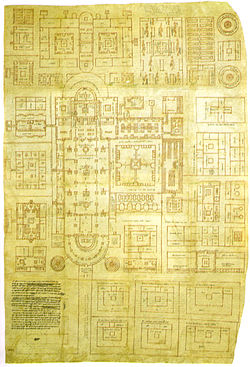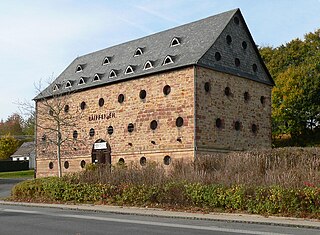
A tithe barn was a type of barn used in much of northern Europe in the Middle Ages for storing rents and tithes. Farmers were required to give one-tenth of their produce to the established church. Tithe barns were usually associated with the village church or rectory, and independent farmers took their tithes there. The village priests did not have to pay tithes—the purpose of the tithe being their support. Some operated their own farms anyway. The former church property has sometimes been converted to village greens.
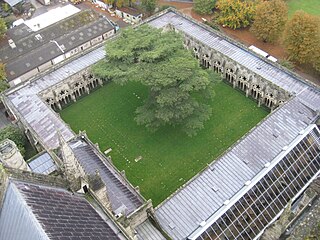
A cloister is a covered walk, open gallery, or open arcade running along the walls of buildings and forming a quadrangle or garth. The attachment of a cloister to a cathedral or church, commonly against a warm southern flank, usually indicates that it is part of a monastic foundation, "forming a continuous and solid architectural barrier... that effectively separates the world of the monks from that of the serfs and workmen, whose lives and works went forward outside and around the cloister."
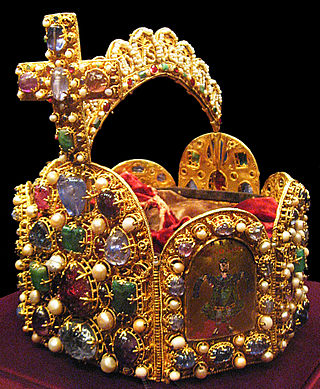
The Imperial Crown of the Holy Roman Empire, a hoop crown with a characteristic octagonal shape, was the coronation crown of the Holy Roman Emperor, probably from the late 10th century until the dissolution of the Holy Roman Empire in 1806. The crown was used in the coronation of the King of the Romans, the title assumed by the Emperor-elect immediately after his election. It is now kept in the Imperial Treasury at the Hofburg in Vienna, Austria.

The Imperial Regalia, also called Imperial Insignia, are regalia of the Holy Roman Emperor. The most important parts are the Crown, the Imperial orb, the Imperial sceptre, the Holy Lance and the Imperial Sword. Today they are kept at the Imperial Treasury in the Hofburg palace in Vienna, Austria.
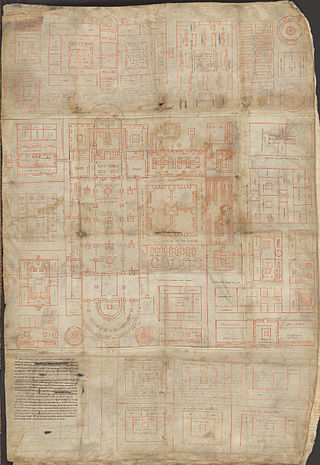
The Plan of Saint Gall is a medieval architectural drawing of a monastic compound dating from 820–830 AD. It depicts an entire Benedictine monastic compound, including church, houses, stables, kitchens, workshops, brewery, infirmary, and a special building for bloodletting. According to calculations based on the manuscript's tituli the complex was meant to house about 110 monks, 115 lay visitors, and 150 craftmen and agricultural workers.

Ernst Hartwig Kantorowicz was a German historian of medieval political and intellectual history and art, known for his 1927 book Kaiser Friedrich der Zweite on Holy Roman Emperor Frederick II, and The King's Two Bodies (1957) on medieval and early modern ideologies of monarchy and the state. He was an elected member of both the American Philosophical Society and the American Academy of Arts and Sciences.
Edward Hetzel Schafer was an American historian, sinologist, and writer noted for his expertise on the Tang dynasty, and was a professor of Chinese at University of California, Berkeley, for 35 years. Schafer's most notable works include The Golden Peaches of Samarkand and The Vermilion Bird, which both explore China's interactions with other cultures and regions during the Tang dynasty.
Samuel James Hume was an American dramatic director, producer, art museum director, and book dealer.

Great Coxwell Barn is a Medieval tithe barn at Great Coxwell, Oxfordshire, England. It is on the northern edge of the village of Great Coxwell, which is about 9 miles (14 km) northeast of Swindon in neighbouring Wiltshire.

James Joseph Rorimer, was an American museum curator and former director of the Metropolitan Museum of Art, where he was a primary force behind the creation of the Cloisters, a branch of the museum dedicated to the art and architecture of Medieval Europe. During World War II, Rorimer served in the U.S. Army's Monuments, Fine Arts and Archives Section, a.k.a. the "Monuments Men," protecting cultural sites and recovering stolen art work.

Ernest Born (1898−1992) was an architect, designer, and artist based in California. He and his wife Esther Baum Born (1902−1987) collaborated on diverse projects in the San Francisco Bay Area from 1936 on. She was also a notable architectural photographer.
James Lockhart was a U.S. historian of colonial Spanish America, especially the Nahua people and Nahuatl language.

In architecture, an overhang is a protruding structure that may provide protection for lower levels. Overhangs on two sides of Pennsylvania Dutch barns protect doors, windows, and other lower-level structures. Overhangs on all four sides of barns and larger, older farmhouses are common in Swiss architecture. An overhanging eave is the edge of a roof, protruding outwards from the side of the building, generally to provide weather protection.
Charles W. Jones (1905–1989) was a medievalist scholar who served on the faculties of Cornell University and the University of California, Berkeley. He is noted for his work on Bede, the development of the ecclesiastical calendar, medieval hagiography, and Carolingian aesthetics. At his death a major work titled The Age of the Book: Christian Foundations of Western Literature was left unfinished.
Robert E. Lerner is an American medieval historian and professor of history emeritus at Northwestern University.
Arthur Gilchrist Brodeur was a scholar of early English, German, and Old Norse literature at the University of California, Berkeley. He is known primarily for his scholarly work on Beowulf and his translation of Snorri Sturluson's Prose Edda for The American-Scandinavian Foundation, but also as a writer of pulp fiction and for his left-wing politics.
The Levering Act was a law enacted by the U.S. state of California in 1950. It required state employees to subscribe to a loyalty oath that specifically disavowed radical beliefs. It was aimed in particular at employees of the University of California. Several teachers lost their positions when they refused to sign loyalty oaths.
Carolyn Marino Malone is an American medievalist and academic. She is professor of art history and history at USC Dornsife College, Los Angeles, California, with a PhD in Art History and Medieval Studies (1973) from the University of California, Berkeley. Her research interests are English and French Romanesque and Gothic architecture and sculpture. She has published books on sculptural finds at Canterbury Cathedral, the abbey of St Bénigne in Dijon, the façade of Wells Cathedral, and monastic life in the Middle Ages. She served as Vice-President (1996-1997) and President (1999) of Art Historians of Southern California; Domestic Advisor to the Board of Directors of the International Center of Medieval Art (1984-1987); and was on the board of directors of the Medieval Association of the Pacific (1986-1989). She is a member of the Society of Architectural Historians.

Frederick the Second is a biography of Frederick II, Holy Roman Emperor, by the German-Jewish historian Ernst Kantorowicz. Originally published in German as Kaiser Friedrich der Zweite in 1927, it was "one of the most discussed history books in Weimar Germany", and has remained highly influential in the reception of Frederick II. The book depicts Frederick as a heroic personality, a messianic ruler who was "beseeltes Gesetz", the law given soul, but also a charismatic and calculating autocrat—"probably the most intolerant emperor that ever the West begot".
The Carolingian Church encompasses the practices and institutions of Christianity in the Frankish kingdoms under the rule of the Carolingian dynasty (751-888). In the eighth and ninth centuries, Western Europe witnessed decisive developments in the structure and organisation of the church, relations between secular and religious authorities, monastic life, theology, and artistic endeavours. Christianity was the principal religion of the Carolingian Empire. Through military conquests and missionary activity, Latin Christendom expanded into new areas, such as Saxony and Bohemia. These developments owed much to the leadership of Carolingian rulers themselves, especially Charlemagne and Louis the Pious, whose courts encouraged successive waves of religious reform and viewed Christianity as a unifying force in their empire.




